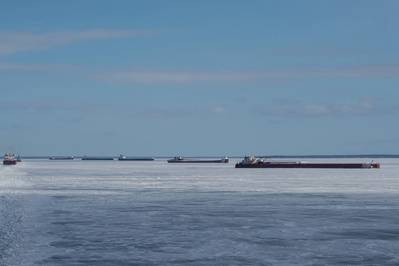Lack of Icebreakers Hinders Great Lakes Shipping
A lack of U.S. Coast Guard icebreaking capacity is hindering shipping on the Great Lakes, a U.S. maritime industry coalition said on Thursday.
During this year’s ice season, the U.S.-flag Great Lakes shipping industry lost the equivalent of a month due to delays in ice covered waters, according to the Great Lakes Maritime Task Force, which represents U.S.-flag vessel operators, shipboard and longshore unions, port authorities, cargo shippers, terminal operators, shipyards and other Great Lakes interests. Some 1.645 million tons of cargo carrying capacity was delayed for 679.5 hours or 28 days due to ice conditions on Lake Superior, Lake Huron, Lake Michigan and in Green Bay and a lack of Coast Guard icebreakers to meet the needs of commerce, the group said.
The Great Lakes commercial maritime industry generates more than $25 billion in economic activity, yet it receives only a fraction of the attention it deserves, according to Jim Weakley, president of the Great Lakes Maritime Task Force.
“It amazes me that a cargo container stuck in Chesapeake Bay or in the Suez Canal gets worldwide attention and that happens on the Great Lakes every year,” Weakley said. “The loss of one day of shipping is tremendous, but a month is devastating. Imagine if highways in the northern states didn’t have enough snowplows to keep traffic moving during frequent winter storms and sat on the road for a month…it is unacceptable.”.
Great Lakes ice conditions this past winter were “average” to “slightly below average” during the bulk of the icebreaking period, according to the National Oceanic and Atmospheric Administration (NOAA). Still, the U.S. Coast Guard’s aging fleet of six 40-year-old small icebreaking tugs and only one heavy icebreaker failed to keep up, the Great Lakes Maritime Task Force said, noting that the U.S. Coast Guard lost five icebreakers to engineering casualties at the beginning of the ice season, just when they were needed most.
As a result of the insufficient icebreaking capabilities, several ships, including both U.S.- and Canadian-flagged lakers, faced perilous journeys through ice infested waters that nearly forced a vessel aground in the Straits of Mackinac and shutdown waterways. At one point several vessels were stuck in eastern Lake Superior for more than three days. Multiple vessels were shoved near the edge of the navigational channels as ice floes over a foot thick shifted which lasted up until mid-April.
“The Coast Guard needs more icebreakers on the Fourth Sea Coast. We have 237,000 jobs depending on a reliable Great Lakes Navigation System. In addition, our sailors deserve to feel safe navigating our waterways regardless of the time of year,” said John D. Baker, International Longshoremen’s Association and vice president of the Great Lakes Maritime Task Force.
While progress fixing the icebreaking issue has been slow, it is moving forward thanks to key Great Lakes Senators and Congressional Representatives, the Great Lakes Maritime Task Force said. Over the past year both the current Commandant of the U.S. Coast Guard and the nominee to replace him testified before the Senate Commerce Committee acknowledging the need for another heavy Great Lakes icebreaker. In addition, the Great Lakes Winter Commerce Act has passed the House in the Coast Guard Authorization Bill which authorizes full funding for the new icebreaker, mandates transparent and accurate performance measures, and commissions a study by the Government Accountability Office (GAO) to examine the impacts and needs for additional U.S. Coast Guard icebreakers on the Great Lakes.














